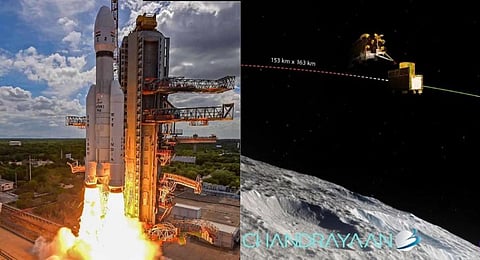

Chandrayaan-3, ISRO's third lunar exploration mission, is all set to create history by landing near the uncharted south pole of the Moon. The mission comprising the lander (Vikram) and the rover (Pragyan) is scheduled to touch down at 6:04 pm on Wednesday.
If the Chandrayaan-3 mission succeeds in touching down and landing a robotic lunar rover in ISRO's second attempt in four years, India will become the fourth country to master the technology of soft-landing on the lunar surface after the US, China and the erstwhile Soviet Union.
India will, however, be the first to reach the south pole of the Moon. All the previous spacecraft to have reached the Moon landed in the equatorial region, a few degrees latitude north or south of the lunar equator.
The powered braking of the Vikram lander will begin at 5.45 pm with the retro firing of four thruster engines to reduce speed.
The critical process of soft-landing has been dubbed by ISRO scientists as "17 minutes of terror" as the entire process will be automated -- the lander has to fire its engines at the right times and altitudes, use the right amount of fuel, and scan the lunar surface for any obstacles or hills or craters before finally touching down.
At an altitude of 150 metres, Vikram’s sensors will scan the surface to check for obstacles before final descent. If the sensors spot a hill or a boulder at the landing spot, it can move laterally up to 150 metres to a better landing spot.
If all goes well, after Vikram settles on the lunar surface, it will release the rover on board.
“After powered descent onto the landing site, there will be deployment of the ramp, with the rover coming out. After this, all the experiments will take place one after the other — all of which have to be completed in just one day on the Moon, which is 14 (Earth) days,” ISRO chief S Somanath said.
The Rs 600 crore Chandrayaan-3 mission was launched on July 14 by the Launch Vehicle Mark-III (LVM-3) rocket for a 41-day voyage to the lunar south pole. The soft-landing is being attempted days after Russia's Luna-25 spacecraft crashed into the Moon after spinning out of control.
ISRO chief Somanath had recently said the most critical part of the landing will be the process of reducing the velocity of the lander from a height of 30 km, and the ability to reorient the spacecraft from the horizontal to vertical direction. "This is the trick we have to play here," he said.
Instead of a success-based design in Chandrayaan-2, the space agency opted for a failure-based design in Chandrayaan-3, focusing on what can fail and how to prevent it to ensure a successful landing, the ISRO chief added.
(With inputs from agencies)